MARKET OVERVIEW
The global aesthetic dermatology market in the healthcare industry will stand as a specialized segment centered around procedures and treatments aimed at improving appearance through medical solutions. Consequently, this market will evolve in response to the growth of technological capabilities and the development of consumer propensities for non-invasive or minimally invasive procedures. The actual goals will differ in terms of aesthetics, but fundamentally, the market will include dermatological procedures developed to rectify features or conditions considered undesirable, often in the absence of a medical necessity.
Thus, this market is conversely not confined within classical clinical frameworks but instead will see its definition being expanded by intersecting cosmetic science with device-based skin procedures and image-guided techniques. The alignment of clinicians, researchers, and device manufacturers will create new standards of dermatological care by refining approaches targeted for all skin types and different aging patterns. While these would enhance individual appearance, they also support greater trends in wellness and preventive care through aesthetic means.
The global aesthetic dermatology market will operate through a range of treatments applied to various layers of skin that align with specific aesthetic considerations. From laser systems to injectables, from body-contouring platforms to skin-based technologies, the industry will organize itself around factors like efficiency, patient comfort, and visual outcomes. These treatments will more and more combine evidence-based dermatological insights with precise digital guidance. Yet, demand from male and female clients from various age groups will also broaden innovation scope and procedural diversity. The further specialization of medical practitioners within this field will give rise to discrete categories of aesthetic services tailor-made according to demographics, skin biology, and cultural proclivities.
Advanced technologies and their medical validation are to be the other defining feature of this market. Accordingly, devices and products used will need to be certified and continuously improved to meet ever-increasing standards of performance and safety. High-frequency ultrasound systems, microneedling devices, fractional lasers, and neuromodulators will define the areas of services catering to this demarcation.
The global aesthetic dermatology market expands further into training, service design, and patient engagement strategies. Clientele and institutions will place trustful weight upon always visual documentation and long-term follow-up. User experience will become a distinguishing factor for competition in consultation and post-treatment care. Devices for digital transformation will ultimately include online skin assessment and AI-based diagnosis, which will further aid the clinics in procedural safety and personalized approaches. These systems will develop a transparent and theory-based decision-making process for the client.
As the industry develops models that cut through industrial disciplines such as cosmetic chemistry, software, hardware, and clinical competency, Global Aesthetic Dermatology will start reshaping consumers, conceptualizing the manner in which aesthetic outcomes are delivered. It will consider involvement not only through medical centers but also through boutique-style specialist clinics, skin-focused wellness lounges, and collaborative spaces with other beauty professionals.
Global aesthetic dermatology market is estimated to reach $6,395.92 Million by 2032; growing at a CAGR of 5.1% from 2025 to 2032.
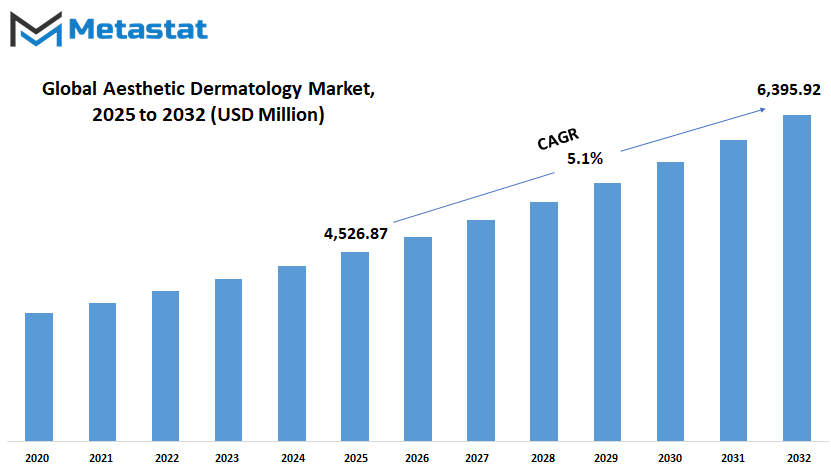
GROWTH FACTORS
The global aesthetic dermatology market is likely to see significant growth in the coming years, driven largely by changing consumer behavior and fast-moving innovations in technology. More people than ever are becoming interested in ways to improve their appearance, especially when it comes to aging. This rising interest is not just limited to a specific age group or region. It reflects a broader shift in how people view personal care and skin health. As individuals become more conscious about how they look and feel, they are turning to aesthetic dermatology for solutions that offer visible improvements without major disruption to their lives.
One of the strongest growth factors is the increasing demand for treatments that target signs of aging and boost skin quality. Consumers today are not just looking for traditional skincare products. They want fast, noticeable results and are willing to invest in procedures that offer them. This demand has led to a surge in treatments such as botulinum toxin injections, dermal fillers, and skin resurfacing. These procedures, while once considered exclusive, are now becoming more common, especially as more clinics open and awareness spreads through social media and word-of-mouth.
At the same time, there are rapid advancements in technologies that are changing how treatments are done. Laser and light-based therapies, for instance, have become more precise and less painful, attracting a broader audience. Non-surgical methods are being developed that give results close to surgery without the downtime or risks, making them more appealing to consumers who want convenience along with safety. These innovations are opening up more choices and helping make aesthetic dermatology feel more accessible.
Despite this positive trend, there are still challenges that could slow down market growth. One major concern is the high cost of many procedures. Since most of these treatments are not covered by insurance, they remain out of reach for many people. In addition, the risk of complications and the need for trained experts means that not all facilities can offer the same level of care, which can impact trust and safety.
Looking ahead, the growing interest in customized skincare and treatments designed for specific needs will likely shape the future of the market. As non-invasive options become more refined and tailored, they are expected to draw in new users. These shifts will continue to create opportunities, suggesting a promising path for the global aesthetic dermatology market in the years to come.
MARKET SEGMENTATION
By Type
The global aesthetic dermatology market is set to grow steadily as more people look for ways to improve their appearance and boost their self-confidence. In the years ahead, this industry will likely see more focus on non-invasive and minimally invasive treatments, making procedures safer and more appealing to a wider group of people. With the rise in awareness around skincare and physical appearance, both men and women are becoming more open to using aesthetic treatments as part of their regular self-care routine.
By type, the market is expanding in different directions. Injectables will continue to gain popularity, especially for people who want fast results without long recovery times. These include treatments like wrinkle reducers and fillers, which help smooth out facial lines and restore volume. Energy-based devices are also making a strong mark. They use methods such as laser and light therapy, which are becoming more advanced and tailored to meet individual needs. These devices offer treatment options that are less painful and often show visible improvements in a shorter time.
Topical products are another part of the global aesthetic dermatology market that will grow. These are creams, serums, and other skincare solutions that work on the surface of the skin. As technology improves, topical treatments will likely become more effective and offer longer-lasting results. People are looking for skincare that works at home but still gives a professional touch, and this area will play a key role in fulfilling that demand.
Body contouring devices are also seeing more interest. They help shape and tone the body without the need for surgery. As people look for ways to maintain their body without long recovery times or risks, these devices will become more common in both clinics and at-home use. Cosmetic surgery, although more invasive, still holds an important place. Some individuals prefer long-term results and are willing to undergo surgery to achieve them. This area will continue to develop with newer techniques that aim to reduce downtime and improve outcomes.
Other treatments that don’t fit into the main categories will also find space in this growing market. These may include future methods that are not yet widely used or are still under development. As research continues and customer expectations grow, the global aesthetic dermatology market will keep moving toward solutions that are safer, faster, and more effective.
By Surgery Type
The global aesthetic dermatology market is gradually transforming as more people seek treatments that improve their appearance without needing major procedures. This shift is mainly seen in the way surgeries are performed. There is a growing preference for techniques that do not require large cuts or extended healing times. People today are more interested in procedures that offer noticeable results with little discomfort or time away from their daily routines. This demand has pushed the market toward two main categories: minimally invasive and non-invasive surgeries.
Minimally invasive procedures involve smaller tools and fewer risks. They might include minor injections or small devices that help with skin tightening, fat reduction, or wrinkle treatment. Since these methods reduce pain and recovery time, they are more appealing to people who want subtle yet effective changes. Non-invasive treatments take this even further. They work without any need to cut into the skin. These procedures often rely on lasers, radio waves, or light-based technology. Because they are painless and do not need any downtime, they are quickly gaining popularity across many age groups. Younger individuals are using them for prevention, while older patients see them as a gentle way to maintain a youthful look.
Looking ahead, technology will continue to shape the global aesthetic dermatology market. Tools will become smarter and more accurate. Treatments will be more tailored to each person’s skin type, age, and personal goals. Artificial intelligence may be used to predict results before treatment even begins, allowing users to make better choices. There will likely be a greater mix of science and beauty, with doctors using advanced methods that produce natural-looking results. In the future, people may also be able to combine different kinds of procedures during a single visit, saving both time and effort.
This growing interest in new methods reflects changing attitudes. Beauty is no longer about dramatic changes; it's about looking fresh and feeling confident without long recoveries or risks. The industry will likely continue moving in this direction, focusing more on comfort, safety, and personal preferences. As more people choose these modern options, the global aesthetic dermatology market will keep growing steadily. With innovation leading the way, it will remain an area where science meets self-care in a way that feels easy and accessible for all.
By Application
The global aesthetic dermatology market is growing steadily, shaped by increasing awareness of skincare, rising demand for non-invasive treatments, and the desire to enhance appearance with minimal recovery time. As more people prioritize personal grooming and invest in treatments that offer visible improvements, the market will continue to expand. With changing lifestyles and stress factors influencing skin health, cosmetic dermatology is being viewed not just as a luxury but as a part of self-care.
By application, the global aesthetic dermatology market spreads across several treatment areas. Wrinkle reduction is one of the most popular segments, as individuals seek ways to maintain youthful-looking skin. Skin tightening also continues to attract attention, especially among those looking for firmer skin without undergoing surgery. These procedures are becoming more advanced and accessible, helping people feel more confident about their appearance.
Pigmentation removal is another major area that will keep gaining importance. With factors like sun exposure, pollution, and hormonal changes affecting skin tone, more people are looking for safe and lasting solutions. Similarly, scar treatment is becoming a regular choice for those dealing with acne scars, surgical marks, or injuries. As technology improves, such treatments will become more refined, offering better results and shorter healing periods.
Body contouring is also shaping the market’s direction. People are looking for ways to improve their body shape without the risks of surgery. Treatments aimed at fat reduction and skin sculpting are now being used by a wider audience. Hair removal, which was once seen as a one-time or occasional need, is now becoming a long-term solution thanks to laser and light-based technologies. These treatments appeal to those seeking convenience and long-term results.
There is also space for other treatments that do not fall directly under these categories. These might include procedures for enhancing skin texture, managing large pores, or addressing issues like dark circles and under-eye puffiness. As skincare becomes more personalized, clinics and brands will create treatments that suit individual needs rather than using a one-size-fits-all approach.
Looking ahead, the global aesthetic dermatology market will likely see more innovation, with treatments becoming safer, quicker, and more tailored. As technology progresses and awareness spreads, more people from different backgrounds will explore these treatments not only for beauty but also for self-esteem and well-being. This shift in attitude will continue to drive the market’s future.
By End Users
The global aesthetic dermatology market is steadily gaining attention as people across the world become more aware of skincare and beauty treatments. With modern lifestyles leading to stress, pollution, and poor diet, the desire for skin improvement and personal care has grown. What used to be limited to luxury treatments is now becoming a routine part of self-care for many individuals. This shift is strongly influencing how services are provided and received. More people are seeking treatments not just for medical needs, but also for cosmetic reasons. As this shift continues, the structure of where and how these treatments are offered is expected to change further.
By looking at the types of places people visit for these services, we can better understand how the global aesthetic dermatology market is shaping up. Dermatology clinics will continue to be trusted places where people seek professional advice and treatment. These clinics offer a sense of security and are often equipped with skilled professionals and advanced tools. Patients feel confident in the expertise provided, especially when dealing with long-term or sensitive skin concerns.
Hospitals also play a significant part. While they focus more on clinical outcomes, their growing investment in aesthetic services shows how the demand has pushed even the most traditional medical settings to adapt. Hospitals bring a higher standard of safety and care, making them appealing to those who want both beauty treatments and strong medical backing.
Then there are medical spas, which sit somewhere between a clinic and a beauty center. They are known for offering a relaxing environment while still maintaining certain medical standards. These places often attract people who want comfort along with visible results. Medical spas provide non-surgical treatments that are designed to improve appearance without requiring much recovery time. This makes them appealing to working individuals or those with busy lifestyles.
Beauty clinics continue to grow as well. They cater mostly to customers looking for simple and fast treatments. Although not all of them are led by medical professionals, they are becoming more common in both large cities and smaller towns. As beauty standards and preferences change, beauty clinics are quick to adjust their services to match trends.
Looking ahead, the global aesthetic dermatology market will likely grow due to advances in technology, changing social attitudes, and rising expectations around personal care. Each type of service provider will play its part, shaping how people interact with and benefit from aesthetic dermatology.
|
Forecast Period |
2025-2032 |
|
Market Size in 2025 |
$4,526.87 million |
|
Market Size by 2032 |
$6,395.92 Million |
|
Growth Rate from 2025 to 2032 |
5.1% |
|
Base Year |
2024 |
|
Regions Covered |
North America, Europe, Asia-Pacific Green, South America, Middle East & Africa |
REGIONAL ANALYSIS
The global aesthetic dermatology market is expected to experience steady development across all major regions due to growing awareness about skincare, technological improvements, and shifting beauty standards. Regional patterns reflect different social, economic, and cultural preferences, which influence how people engage with aesthetic treatments. North America continues to show strong growth, especially in the United States and Canada, where advanced skincare solutions and cosmetic procedures are widely accepted. This region also sees consistent demand driven by a population that values appearance, combined with the presence of leading cosmetic dermatology clinics and professionals. Mexico is gradually catching up as awareness and accessibility grow, especially in urban centers.
In Europe, the market will keep expanding, supported by countries like Germany, France, Italy, and the UK. There is a noticeable preference for non-invasive or minimally invasive procedures, and that trend is expected to shape the market’s progress in this region. Europe's mature healthcare systems and regulatory standards are helping to maintain quality and safety, which encourages more people to explore dermatological solutions. Additionally, an aging population in many European countries continues to seek cosmetic treatments that help maintain youthful features, fueling steady demand.
Asia-Pacific is likely to emerge as one of the most dynamic regions for the global aesthetic dermatology market. Countries such as China, India, Japan, and South Korea are seeing a shift in consumer behavior, with growing interest in beauty care. Increasing disposable incomes, broader acceptance of aesthetic services, and an enthusiastic younger population will all contribute to growth. South Korea, in particular, stands out for its cosmetic innovation and influence on global beauty trends. As people in this region become more comfortable with aesthetic procedures, the market will naturally move forward.
South America is also gaining momentum, especially in Brazil and Argentina. Though the pace is slower compared to North America or Asia-Pacific, demand is gradually building due to increased visibility of treatments and a stronger focus on personal appearance. Urban populations are beginning to explore options that were previously considered luxury services.
In the Middle East and Africa, interest is picking up as well. Countries such as the United Arab Emirates and Saudi Arabia are leading the shift, helped by improving infrastructure and healthcare systems. South Africa and Egypt are also seeing positive changes, with more clinics opening and people becoming familiar with aesthetic treatments. Across all regions, the global aesthetic dermatology market will continue to grow as beauty standards shift, people look for long-lasting skin solutions, and access to care becomes easier.
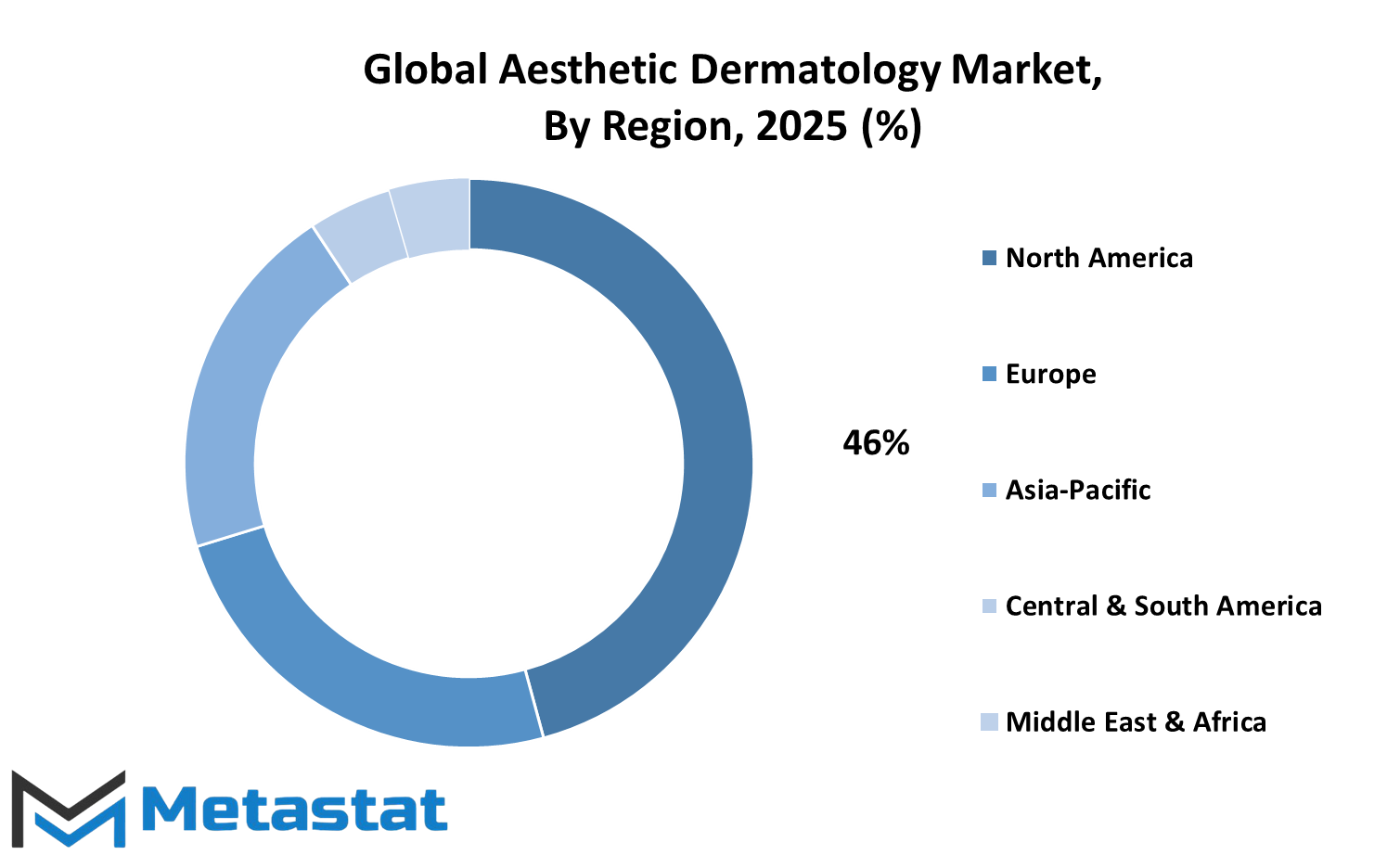
COMPETITIVE PLAYERS
The global aesthetic dermatology market is expected to continue gaining attention as people around the world increasingly show interest in enhancing their appearance through non-invasive or minimally invasive treatments. Over time, skin-related concerns that once required surgical methods are now being addressed through advanced dermatological technologies, which are less painful and require shorter recovery periods. This shift has encouraged both consumers and professionals to embrace aesthetic procedures, and as awareness grows, so does the number of individuals seeking these treatments.
In the future, more people will likely look for cosmetic solutions that provide subtle, natural-looking results. This preference for treatments that improve appearance without major transformation is shaping the direction of the global aesthetic dermatology market. Technology is playing a huge role here. Companies are focusing on creating devices and products that work more efficiently and with fewer side effects. Innovations in lasers, radiofrequency tools, and injectable treatments are leading the way. These advancements aim to offer safer procedures that still deliver visible outcomes.
Competition among the key players in this industry will become more intense as new technologies emerge and customer expectations rise. AmorePacific, Classys Inc., Hugel Inc., and LUTRONIC Corporation are among the companies working to bring forward new techniques and tools. They are investing in research to stay ahead, offering products that stand out through better performance or unique features. Companies like Merz Pharmaceuticals, Lumenis, and Cynosure are also playing strong roles by pushing for both scientific progress and consumer satisfaction. Their efforts are not just focused on innovation but also on making treatments more accessible and suitable for diverse skin types.
Additionally, players such as Candela Corporation, Cutera, Hironic Co., Ltd., and Galderma are likely to explore partnerships and expand into new markets. They are expected to work more closely with clinics and practitioners, training them and supporting them with marketing efforts. Wontech Co., Ltd. and Bausch Health Companies Inc. are also expected to step up their efforts to grow by developing devices that are more adaptive to different needs.
With consumer interest growing and technology constantly improving, competition among these companies will not just remain strong, it will also become more global. This growth pattern suggests a market where companies will continue shaping their offerings to match the desires and concerns of tomorrow’s customers.
Aesthetic Dermatology Market Key Segments:
By Type
- Injectables
- Energy-based Devices
- Topical Products
- Body Contouring Devices
- Cosmetic Surgery
- Other
By Surgery Type
- Minimally Invasive
- Non-Invasive
By Application
- Wrinkle Reduction
- Skin Tightening
- Pigmentation Removal
- Scar Treatment
- Body Contouring
- Hair Removal
- Other
By End Users
- Dermatology Clinics
- Hospitals
- Medical Spas
- Beauty Clinics
Key Global Aesthetic Dermatology Industry Players
- AmorePacific
- Classys Inc.
- Hugel Inc.
- LUTRONIC Corporation
- Merz Pharmaceuticals
- Lumenis
- Cynosure
- Candela Corporation
- Cutera
- Hironic Co., Ltd.
- Galderma
- Wontech Co., Ltd.
- Bausch Health Companies Inc.
WHAT REPORT PROVIDES
- Full in-depth analysis of the parent Industry
- Important changes in market and its dynamics
- Segmentation details of the market
- Former, on-going, and projected market analysis in terms of volume and value
- Assessment of niche industry developments
- Market share analysis
- Key strategies of major players
- Emerging segments and regional growth potential




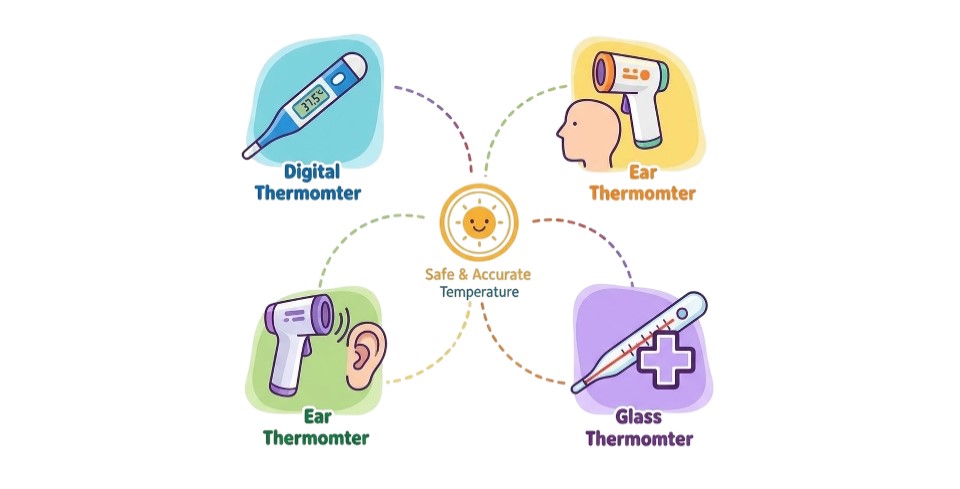
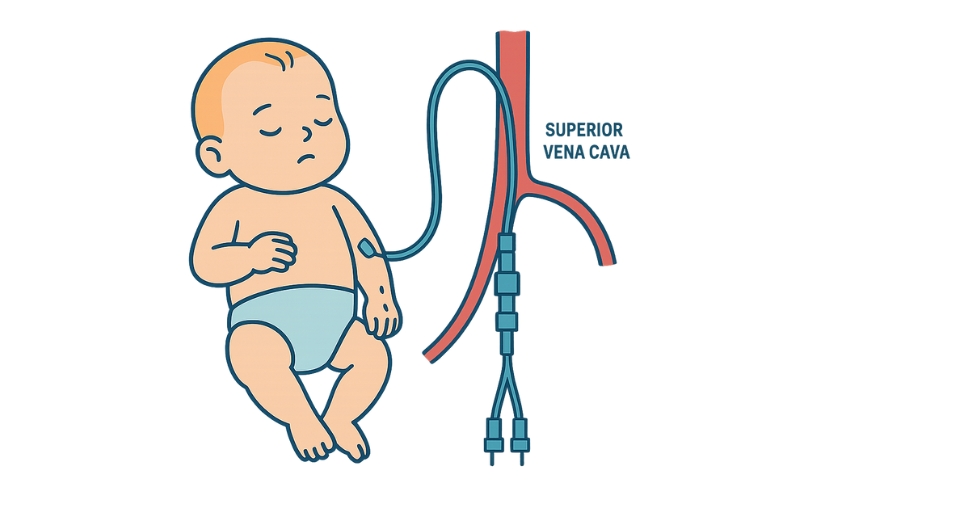
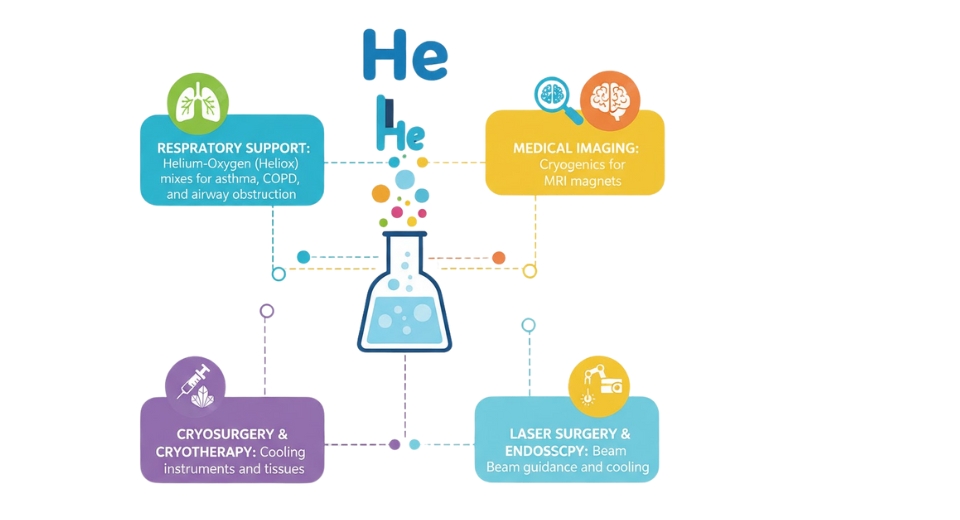

 US: +1 3023308252
US: +1 3023308252






